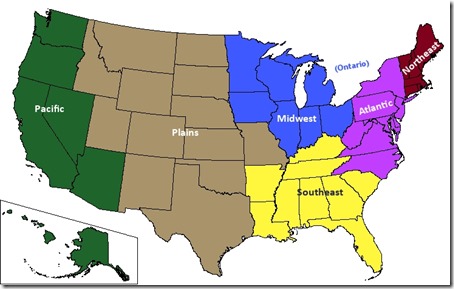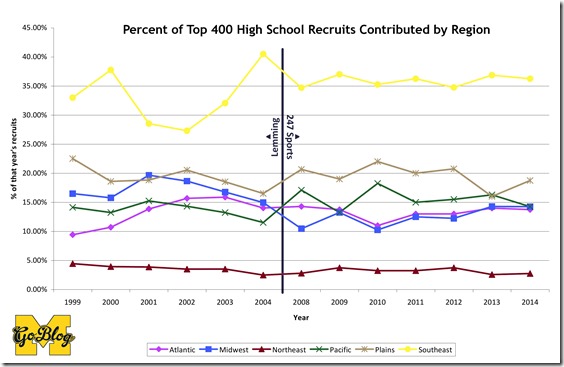Hokepoints Doesn't See a Regional Trend

Yesterday Ace posted a link to the full Lemming recruiting rankings from 1990 to 2004. Just perusing the list is pretty interesting, since accessible recruiting data on a national scale otherwise only goes back as far as the Rivals and Scout databases. Since nobody likes to make their information easy to get at, it'll take some time for this all to be processed.
But for a first stab I did find something I can pull relatively easily from both Lemming's sheets and modern data: where players come from, and where they went. Lemming only had data on where recruits were from going back to 1999. Since it was easiest to grab a Top 400 from 247, I took theirs too, but they run out of rankings before 2008 so there's a gap. It won't matter for this. I broke the nation into regions that quasi-match the traditional conference footprints:
And here's the % of high school recruits that each contributed to Lemming's (on the left) and 247's (on the right) lists:
Who's been telling you that demographics are responsible for the SEC's rise? It's not there. The Big Ten's traditional footprint was providing 15% of the nation's talent in 1999 and the SEC was around 35%; today it's almost the exact same.
[After the jump: regional retention]
Another factoid thrown around about recruiting is it's grown more national, with players leaving not just their states but going to completely different regions. I thought I'd track that to see if certain regions have been bleeding talent more than others now compared to in the past. For this I had to use Rivals (going back to 2010, which is when I ran out of time) because 247 makes it too hard to pull the data on school choice. So:
| Chose School in Home Region | ||
|---|---|---|
| Region | 1999-'04 | 2010-'14 |
| Atlantic | 57% | 48% |
| Midwest | 81% | 71% |
| Northeast | 41% | 28% |
| Pacific | 77% | 78% |
| Plains | 71% | 75% |
| Southeast | 83% | 79% |
| ALL | 74% | 71% |
The Midwest used to be as good as the Southeast among regions that get most of their talent to stay within the footprint, but we've drifted right to the national average (Penn State and Pennsylvania recruits count as Atlantic). It was surprising to see that Big XII and Pac-12 regions tend to retain their top players even better than they used to.
Where are they going, these vagabond children?
| Destination of Recruits Going Out-of-Region | ||
|---|---|---|
| Region(Sch) | 1999-'04 | 2010-'14 |
| Atlantic | 13% | 11% |
| Midwest | 36% | 24% |
| Northeast | 6% | 7% |
| Pacific | 8% | 12% |
| Plains | 13% | 18% |
| Southeast | 25% | 28% |
And finally something matches the narrative. The Big Ten seems to be getting fewer national recruits, relying instead on a footprint that's still just average for a major conference. When the Big Ten was more than a typical major conference, it was drawing a ton of kids from California and Texas and whatnot. HOWEVA, that's still a greater share of the travelers than anywhere but the Southeast. As for Michigan:
| Composition of Michigan's Classes* | ||
|---|---|---|
| Region(Hm) | 1999-'04 | 2009-'14 |
| Midwest | 59% | 69% |
| Atlantic | 14% | 15% |
| Southeast | 11% | 5% |
| Plains | 7% | 8% |
| Pacific | 9% | 2% |
| Northeast | 0% | 2% |
*Top-400 players only
Carr used to get a lot of guys from under the Pac Ten's nose (Larry Stevens, Leon Hall, Matt Gutierrez, etc.) and had that ridiculous streak of stealing just about everything of value from Pennsylvania (Henne, Mundy, Massaquoi, Marlin, Breaston, etc.) in the early 2000s. He also had an underrated ability to pull kids out of SEC strongholds, though many of them didn't stick on the roster more than a couple of years, or didn't pan out.
February 4th, 2014 at 11:53 AM ^
But putting Texas in "The Plains" with the Dakotas, Montana, and Idaho strikes me as more than a bit silly. I'd put TX in with the SE schools and name the category South/Southeast.
February 4th, 2014 at 11:58 AM ^
That's certainly debatable point, but I think it might also wok as "the Plains" represent Big 12 country. In any case, there's no denial that talent is most heavily concentrated in the SEC country plus Texas.
February 4th, 2014 at 12:09 PM ^
accurate to depict TX, OK, and maybe AR as its own region.
February 4th, 2014 at 12:20 PM ^
with texas having so many D1 football programs, i'd almost call it it's own region. But what Seth has here in terms of the historical what-became-the Big 12 does make sense.
February 4th, 2014 at 12:24 PM ^
February 4th, 2014 at 12:23 PM ^
I have concluded that the reason ohio has generally the best players in the big ten foot print is because it borders sec territory.
February 4th, 2014 at 12:33 PM ^
91, of course. And it really continues to be a south-westerly shift:
http://www.theatlantic.com/business/archive/2012/12/the-fastest-growing…
Still, a useful corrective.
I'm hopeful about Nussmeier, but I really start to see Hoke, including through the prism of this Gibbons deal, as pretty hapless, more good old boy than leader. We've got some fairly tall weeds to climb out of.
February 4th, 2014 at 12:35 PM ^
after reviewing lemming's data, i see a big problem: lemming's rankings were really bad. plenty of his top recruits never sniffed the NFL.
recruiting rankings today is a much more exact science than it used to be, probably because there are more people doing it, making seeing prospects in person easier. technology obviously also made viewing tape easier. huge camps makes comapring prospects easier as well. previously, lemming relied in large part on the opinions of others, without actually seeing many prospects in person and seeing only a small segment of highlights on tape. also, i believe that he's based in chicago, so his evaluateions were more midwest-focused than recruiting rankings are now. as countless articles and diaries here have shown, recruting rankings today are actually pretty good at predicting whether a player will be drafted, how high and other measures, such as all-conference, all-america, etc. lemming failed miserably in that regard.
i bet that if you look at the recruits who panned out on lemming's rankings and compared that to today, you'd see that a greater percentage of top players are going to the SEC.
February 4th, 2014 at 2:25 PM ^
"lemming's rankings were really bad. plenty of his top recruits never sniffed the NFL."
If Lemming is evaluating them for their success in college that can be a quite different evaluation. For example, Henry Hill and Jim Stillwagon were incredible college players but Hill was never drafted and Stillwagon was a 5th round pick in the NFL who went to the CFL. I haven't looked at any of the data so I can't say whether he did a good job using that criteria.
I agree with your other points in the second paragraph.
February 4th, 2014 at 12:58 PM ^
obviously-I assume, and its interesting that the difference between 99-04 and 10-14 was that all the other conferences saw either a rise in kids within their demographic or a statistically insignificant drop in kids, EXCEPT the BgTn where there was a 12% decline. More top ranked kids from the midwest are going elsewhere...not necessarily to the SEC but all over the country. Michigan appears to not be the national draw that they were 10 years ago as well.
February 4th, 2014 at 3:09 PM ^
Lemming always hugely overrated midwest recruits in those days as compared to others who did rankings. Chicago bias.
February 4th, 2014 at 11:34 PM ^


Comments